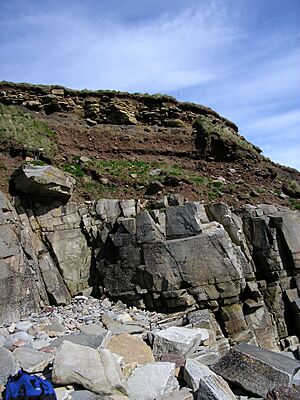Bedrock facts for kids
Bedrock is the solid rock found deep under the Earth's surface. Think of it as the strong foundation of our planet. Above this solid rock, you usually find layers of broken bits of rock, soil, sand, pebbles, and other loose materials.
The very top surface of the bedrock is called the rockhead. Finding the rockhead is a very important job for engineers when they are planning to build things like roads, bridges, or tall buildings. They might dig holes, drill into the ground, or use special tools that send signals into the Earth to find out how deep the bedrock is.

Sometimes, the loose material on top of the bedrock can be very thick. This loose material is often called drift. It can be hundreds of meters deep, meaning the solid bedrock is far, far below the surface!
When you look at a special map called a geologic map, it often shows where the bedrock would be if all the soil and loose layers on top were removed. This helps scientists and engineers understand the Earth's structure.
Contents
What is Bedrock?
Bedrock is the main, solid rock layer that forms the Earth's crust. It's different from the loose soil and rocks you see on the surface. Bedrock is strong and stable. It can be made of many different types of rock, like granite, limestone, or sandstone. These rocks formed over millions of years.
Where Do We Find Bedrock?
Bedrock is found all over the world, beneath continents and oceans. In some places, like mountains or cliffs, the bedrock might be right at the surface. This is called an outcrop. But in many other places, it's hidden under layers of soil, sand, and other loose materials. These loose layers are often called "superficial deposits" or "drift."
Why is Bedrock Important?
Bedrock is super important for many reasons:
- Building Foundations: When engineers build large structures, they need a strong base. Bedrock provides this stable foundation, making sure buildings don't sink or shift.
- Water Supply: Bedrock can hold groundwater in cracks and spaces. This water is often used for drinking and farming.
- Natural Resources: Many valuable minerals, metals, and fossil fuels are found within bedrock. Geologists study bedrock to find these resources.
- Understanding Earth's History: The type of bedrock and how it's arranged tells scientists a lot about the Earth's past. It shows how mountains formed, how continents moved, and what ancient environments were like.
How Do We Study Bedrock?
Scientists and engineers use several methods to study bedrock:
- Drilling: They use special drills to make deep holes and bring up samples of the rock, called "cores." These cores show the different layers of bedrock.
- Excavation: Sometimes, they dig trenches or pits to expose the bedrock directly. This is common on construction sites.
- Geophysical Surveys: These methods use sound waves, electrical currents, or magnetic fields to "see" through the ground without digging. They can create maps of the bedrock layers hidden below.
See also
 In Spanish: Roca madre para niños
In Spanish: Roca madre para niños

